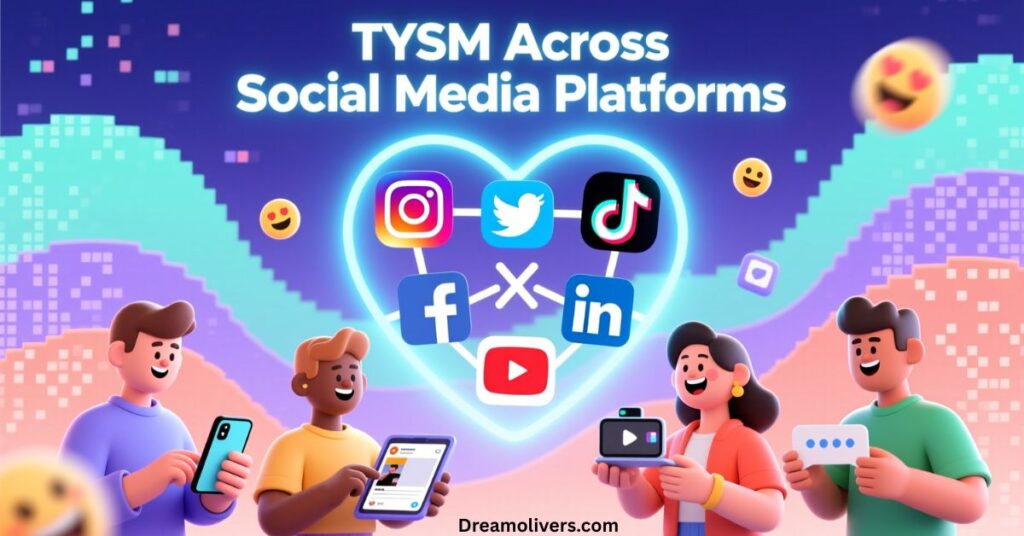In 2025, digital communication continues to shape how we express gratitude, affection, and appreciation. One abbreviation stands tall among them TYSM, meaning “Thank You So Much.” Whether you’re texting a friend, responding to an email, or dropping a quick comment on Instagram or TikTok, this little acronym packs a lot of emotional weight in just four letters.
But does it always mean the same thing? Let’s unpack the tone, context, and subtle nuances behind TYSM, exploring how its meaning shifts across platforms, audiences, and situations.
What Does TYSM Mean?
At its core, TYSM → “Thank You So Much.” It’s an abbreviation — a condensed form that demonstrates language economy (shortening phrases) while keeping the intent of gratitude intact.
People use TYSM to express genuine thanks, admiration, or polite acknowledgment in text messaging, DMs (Direct Messages), and even email communication. The speech act (gratitude expression) here is clear — you’re showing appreciation, but how it’s perceived depends on tone and context.
Example:
In a friendly text message:
“TYSM for the birthday surprise 🥹💖 You’re the best!”
This shows sincerity, emotive language, and an informal communication style typical of text messaging language.
The Evolution of TYSM in Digital Discourse
Language evolves as fast as the technology we use. The language evolution of TYSM illustrates how people simplify expressions while maintaining emotional impact. It began as TY (“Thank You”) and TYVM (“Thank You Very Much”), later expanding to TYSM for stronger feeling.
This process shows the pragmatics of modern language — how we adapt words for ease and speed in digital discourse.
Example:
On Instagram or TikTok, comments like:
“TYSM for the love, guys 🙏💖”
feel warm and sincere but remain casual. Over time, the phrase has gained a dual connotation — sometimes genuine, other times routine or even automated.
Context and Tone: The Power of Interpretation
In linguistics, context and tone determine how any phrase is received. A friendly tone in Snapchat differs from a professional tone in an email. TYSM can sound heartfelt or robotic, depending on register (formal/informal) and audience awareness.
| Platform | Communication Style | Register | Example |
|---|---|---|---|
| Personal / Playful | Informal | “TYSM for the pics! You made my day 😄” | |
| Professional | Formal | “TYSM for your assistance with the project, Mr. Evans.” | |
| Conversational | Neutral | “TYSM for explaining that — makes total sense now!” | |
| Expressive / Visual | Informal | “TYSM for 10k followers 💖🙏” |
Each example illustrates how tone, register, and discourse context guide the reader’s perception of sincerity or formality.
TYSM vs. TYVM vs. TY
The semantic variation among TY, TYVM, and TYSM shows subtle layers of emotion and intent.
| Abbreviation | Meaning | Typical Use | Emotion Level |
|---|---|---|---|
| TY | Thank You | Quick reply | Neutral |
| TYVM | Thank You Very Much | Slightly formal | Moderate |
| TYSM | Thank You So Much | Friendly, expressive | High |
The lexical choice here reflects not only how thankful you are but also your communication style and politeness strategy.
When TYSM Means More Than Words
Sometimes TYSM carries a heartfelt weight that transcends typing. It’s part of our expressive language, used to convey appreciation without needing an elaborate sentence.
Example 1 — Casual Chat
Emma: “I stayed up late editing your video!”
Liam: “TYSM 🙏 You seriously saved me!”
This short, emotional burst shows emotive language and genuine gratitude expression.
Example 2 — Email Communication
Subject: TYSM for Your Support
Hi Sarah,
TYSM for stepping in to cover my client presentation last week. I really appreciate your help and professionalism. You made a tough situation much easier.
Best,
Daniel
Here, the formality and sincerity are higher, fitting a professional etiquette standard.
Sincerity vs. Shortcut
One question often arises — is TYSM sincere or just a quick slang shortcut? The answer depends on intent and context.
- Sincere: When paired with details or emotional cues (“TYSM for always listening 🥹”).
- Shortcut: When tossed at the end of a thread without emotion (“TYSM.”).
This dual nature mirrors a meaning shift (hiatus concept) — a “pause” in sincerity or meaning where the phrase can feel either genuine or hollow.
TYSM Across Social Media Platforms

Let’s look at how TYSM functions across various social media platforms:
Used in captions or replies, often paired with emojis like 🙏💖.
“TYSM for all the birthday wishes — I feel so loved!”
TikTok
Appears in comment replies to fans or followers.
“TYSM for watching till the end 😍 You guys rock!”
Used in group chats for casual gratitude.
“TYSM everyone for pitching in on the event!”
Appears in threads where users offer help or advice.
“TYSM for the detailed guide — saved me hours!”
Each platform shows a unique usage pattern shaped by sociolinguistic variation — how different social groups or communities use language differently.
Pragmatics of TYSM: Reading Between the Lines

In linguistics, pragmatics studies how meaning changes depending on situation. With TYSM, several factors influence how your message lands:
- Audience awareness: Who you’re talking to
- Discourse context: What came before or after
- Politeness strategy: How you balance warmth with brevity
- Tone: How formal or casual your message sounds
Example – Two Contrasting Uses:
Formal Email:
“TYSM for your prompt response regarding our meeting schedule.”
Text Message:
“TYSM 😭 You seriously came through!”
Both express thanks but use different registers — one professional, one emotional.
TYSM in Professional vs. Casual Tone
Using TYSM in a professional tone can be tricky. It’s concise, but some may find it too informal for corporate settings. In those cases, try “Many Thanks”, “I Truly Appreciate It”, or “Thank You Kindly.”
| Situation | Better Phrase | Example |
|---|---|---|
| Email to boss | Thank You Kindly | “Thank you kindly for approving the budget, Ms. Hughes.” |
| Text to coworker | TYSM | “TYSM for sending those files so fast!” |
| Client follow-up | Much Appreciated | “Your input was much appreciated during the review.” |
Choosing the right phrase is an act of audience awareness and politeness strategy — balancing gratitude with the right communication style.
TYSM and Code-Switching
In modern digital communication, people often shift between styles — known as code-switching. You might use TYSM in a friendly message, then switch to “Thank You So Much” in a professional context.
This flexibility demonstrates language economy and adaptability in digital discourse, proving how TYSM fits naturally into both personal and public speech acts.
The Emotional Side of TYSM
Every “TYSM” carries a small dose of emotion — joy, relief, appreciation, or affection. Its emotive language adds warmth even when space or time is limited.
“TYSM 🥹 You really didn’t have to do that.”
That mix of words and emojis mirrors spoken expressive language, bridging the gap between online and offline gratitude.
Final Thoughts: TYSM and the Future of Gratitude
As text messaging language evolves, abbreviations like TYSM continue to reshape how we express appreciation. Its simplicity hides depth a blend of politeness, emotion, and nuance that adapts to any context.
In 2025 and beyond, TYSM isn’t just shorthand. It’s a reflection of modern communication, blending sincerity vs. shortcut, formality vs. friendliness, and language evolution in real time.
So next time you type TYSM, pause and think:
Are you showing genuine gratitude or just hitting send out of habit?
Either way, it’s proof that even in a world of shrinking words, thankfulness still finds its voice. 🙏💬

DreamOlivers, guided by Tina Hudson, is a spiritual space for inner peace and growth. Offering profound insights, it helps you connect with your higher self. Embrace wisdom and inspiration for a balanced, fulfilling life.

